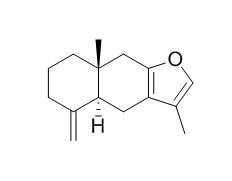Atractylone
Atractylone has inhibitory effects on mast cell-mediated allergic reactions, it regulates the degranulation of mast cell, proves its potential in the treatment of mast cell-mediated allergic reactions.
Inquire / Order:
manager@chemfaces.com
Technical Inquiries:
service@chemfaces.com
Tel:
+86-27-84237783
Fax:
+86-27-84254680
Address:
1 Building, No. 83, CheCheng Rd., Wuhan Economic and Technological Development Zone, Wuhan, Hubei 430056, PRC
Providing storage is as stated on the product vial and the vial is kept tightly sealed, the product can be stored for up to
24 months(2-8C).
Wherever possible, you should prepare and use solutions on the same day. However, if you need to make up stock solutions in advance, we recommend that you store the solution as aliquots in tightly sealed vials at -20C. Generally, these will be useable for up to two weeks. Before use, and prior to opening the vial we recommend that you allow your product to equilibrate to room temperature for at least 1 hour.
Need more advice on solubility, usage and handling? Please email to: service@chemfaces.com
The packaging of the product may have turned upside down during transportation, resulting in the natural compounds adhering to the neck or cap of the vial. take the vial out of its packaging and gently shake to let the compounds fall to the bottom of the vial. for liquid products, centrifuge at 200-500 RPM to gather the liquid at the bottom of the vial. try to avoid loss or contamination during handling.
Sci Rep.2018, 8:15059
Int J Mol Sci.2022, 23(21):12816.
Journal of Applied Pharmaceutical Science2022, 0(00), pp:001-007
Korean Journal of Pharmacognosy.2015, 46(4):352-364
Natural Product Communications2021, 16(9):1-10.
J Chromatogr A.2024, 1714:464544.
Metabolites.2020, 11(1):E11.
Biomed Pharmacother.2023, 162:114617.
Saudi Pharm J.2019, 27(1):145-153
Nat Prod Commun.2017, 12(5):771-778
Related and Featured Products
World J Microbiol Biotechnol. 2012 Feb;28(2):575-84.
Comparison of the effects of fungal endophyte Gilmaniella sp. and its elicitor on Atractylodes lancea plantlets.[Pubmed:
22806853]
The effects of the endophytic fungus Gilmaniella sp. and its elicitor on the defense and metabolic responses of host plants Atractylodes lancea were investigated, in order to understand how to utilize endophytic fungi and their elicitor resources better.
METHODS AND RESULTS:
The results showed that the promotion effect of the fungus on the growth of host plantlets was much better than that of its elicitor. Both fungus and elicitor enhanced defense-related enzyme activities. In fungus-inoculated groups, phenylalanine ammonia lyase and polyphenol oxidase activities increased slowly, and reached a maximum level during the later stages, whereas peroxidase activity peaked in the first few days. Additionally, the activities of chitinase and β-1,3-glucanase were significantly higher than those of the control plants. In elicitor-treated groups, however, most of the enzymes were activated during the early stage, and their highest levels were generally lower than those of the fungus-inoculated groups. Compared with the elicitor, fungal infection improved the photosynthetic rate of the host, and increased carbohydrate levels as well as chlorophyll content in host leaves. The total content of the four main components of volatile oil was also increased in elicitor-treated groups, but there was no particular pattern in this increase. Meanwhile, in the fungus-inoculated groups, the content of Atractylone significantly increased with time, while the content of β-eudesmol decreased.
CONCLUSIONS:
These results indicated that fungal elicitor could substantially improve the total content of volatile oil, while the fungus could more effectively enhance the quality of herbal medicines.
Chem.Biol. Interact., 2016, 258:59–68
Inhibitory effects of atractylone on mast cell-mediated allergic reactions.[Pubmed:
27553716 ]
This study investigated a salutary effect of Atractylone (Atr) which is an active constituent of Pyeongwee-San (KMP6) on mast cell-mediated allergic reactions. Our previous report indicated that KMP6 regulated allergic reactions.
METHODS AND RESULTS:
Thus, this study sought to determine the potential of Atr in vitro models, compound 48/80-stimulated rat peritoneal mast cells (RPMCs), phorbol 12-myristate 13-acetate (PMA) plus A23187-stimulated human mast cell line (HMC-1) cells, and stem cell factor (SCF)-stimulated RPMCs as well as in vivo models, IgE-mediated passive cutaneous anaphylaxis (PCA), compound 48/80-induced systemic anaphylaxis, and compound 48/80-induced ear swelling. The results showed that Atr inhibited compound 48/80-induced RPMCs degranulation, intracellular calcium level, tryptase release, and histamine release. Atr inhibited the up-regulation of p56(lck) tyrosine kinase activity by compound 48/80. And Atr reduced tryptase and histamine releases from PMA plus A23187-stimulated HMC-1 cells. In addition, Atr decreased histidine decarboxylase activity and expression in the activated HMC-1 cells. Atr inhibited SCF-induced morphological alteration and filamentous actin formation in RPMCs. Atr improved IgE-induced PCA reaction by decreasing the levels of histamine, IgE, interleukin (IL)-4, IL-5, IL-6, vascular endothelial growth factor, and IL-13 in the serum of PCA-induced mice. Furthermore, Atr mitigated compound 48/80-induced systemic anaphylaxis and ear swelling.
CONCLUSIONS:
Taken together, these results of this study indicate that Atr regulates the degranulation of mast cell, proving its potential in the treatment of mast cell-mediated allergic reactions.



